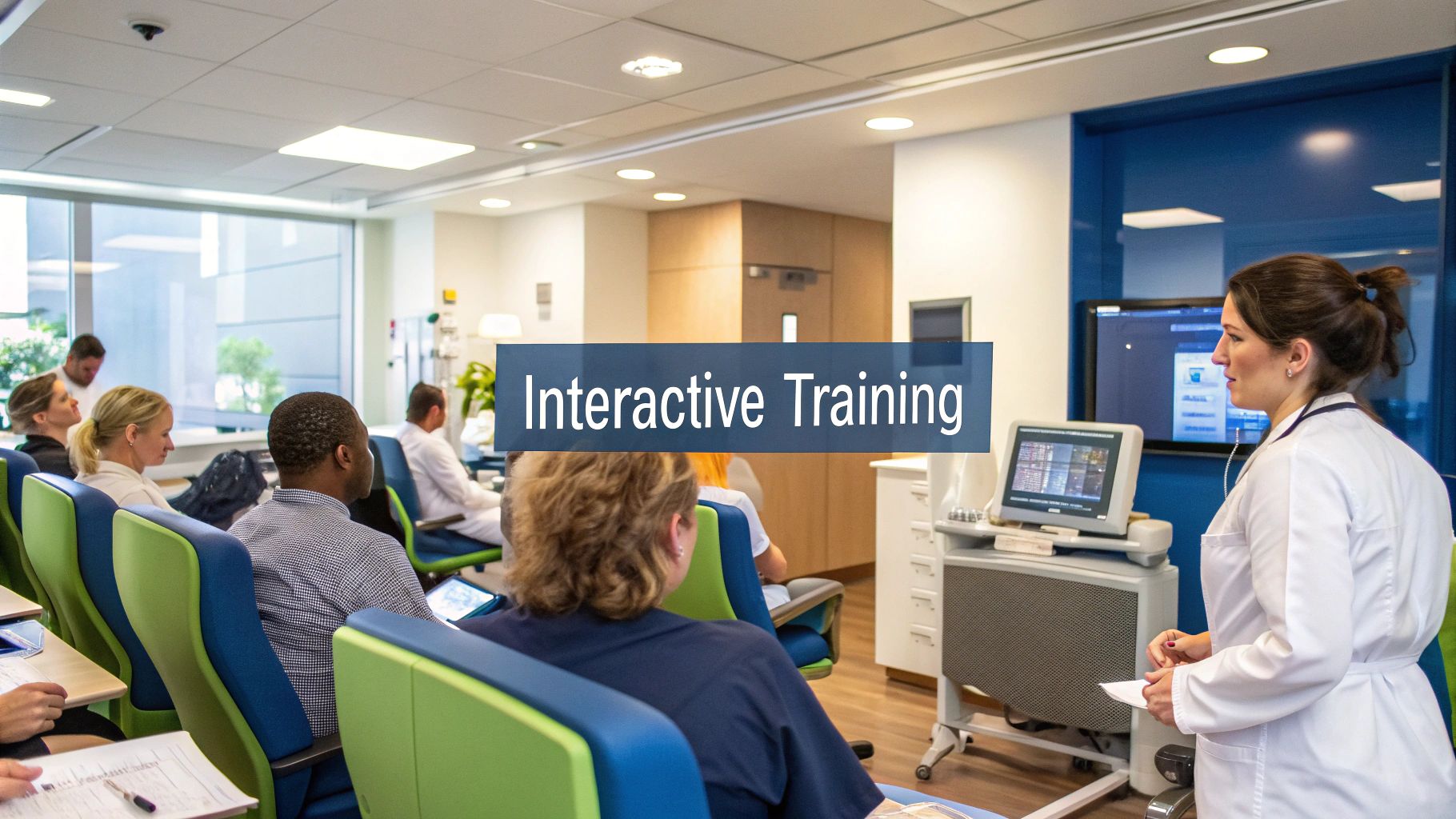Electronic Health Records Training: A Comprehensive Guide to Mastering Modern Healthcare Systems
The Evolution and Business Impact of EHR Systems
The shift from paper charts to electronic health record (EHR) systems has changed healthcare operations at their core. This technological advancement has impacted both clinical practice and business operations, creating an essential need for proper EHR training.
The Digital Healthcare Transition
Early EHR systems focused on converting paper records into digital formats - basic patient information, medical histories, and treatment plans. As technology progressed, EHRs developed into robust platforms supporting provider communication, clinical decision-making tools, and advanced data analytics for better patient care.
Making the Business Case for Training
The widespread use of EHRs presents both challenges and opportunities. Quality training is crucial - without it, healthcare organizations risk reduced efficiency, more mistakes, and lower quality care. Investing in comprehensive EHR training helps staff optimize system capabilities, resulting in better workflows and patient outcomes.
EHR adoption has grown dramatically. According to recent data, 96% of non-federal acute care hospitals and 78% of office-based physicians now use certified EHR systems - up from just 28% of hospitals and 34% of physicians in 2011. Learn more at HealthIT.gov EHR Adoption Statistics.
Maximizing Return on Investment
Good EHR training delivers value beyond basic efficiency gains. Well-trained staff make better use of advanced features like clinical decision support and analytics tools, leading to more accurate diagnoses and treatment plans. Teams with strong EHR skills also adapt more readily to system updates, helping organizations get more long-term value from their investment.
Training Challenges and Solutions
Creating effective EHR training programs requires careful consideration of staff experience, learning preferences, and system complexity. While challenging, this presents opportunities to develop targeted programs that meet specific team needs. Organizations that invest in customized training often see higher engagement, productivity, and ultimately better patient care.
Building Training Programs That Actually Work
Electronic health records (EHR) training has a direct impact on patient care quality and medical staff efficiency. Top healthcare organizations know that basic tutorials aren't enough - they're creating complete training solutions that work for different learning styles and experience levels.
Structuring Programs for Success
A good EHR training program needs both classroom learning and practical experience. Just like learning to drive requires more than reading the manual, staff need hands-on practice with the EHR system. Starting with basic functions and building up to advanced skills helps users gain real confidence. The training should match how they'll use the system in their daily work.
- Step-by-Step Learning: Begin with core functions before advancing to complex features
- Role-Specific Content: Create focused training paths - physicians learn clinical documentation while billing staff focus on claims processing
- Mixed Learning Methods: Use a combination of online modules, classroom sessions, and on-the-job coaching
Engaging Content and Practical Application
Staff learn best when training is interactive and relevant. Rather than dry technical manuals, use engaging content like quizzes, videos and practice scenarios. Think of it like flight training - pilots practice extensively in simulators before flying real planes. Similarly, healthcare staff can master EHR skills in a safe training environment before working with actual patient records.
Research shows that personalized EHR training leads to better results. One study found major improvements when clinicians received extra training after initial system rollout. Read more details in this academic research paper.
Assessment and Continuous Improvement
Regular skill checks help identify where staff excel and where they need extra help. This feedback improves both individual performance and the overall training program. Ongoing support and refresher courses keep everyone up-to-date as EHR systems evolve with new features and updates. This ensures the organization gets full value from its EHR investment.

Bridging the Academic-Professional Gap
Modern healthcare demands that students enter the workforce ready to use Electronic Health Records (EHR) systems. Schools are responding by integrating EHR training directly into their programs. This practical preparation helps ensure graduates can hit the ground running in clinical settings.
Successful Academic Models
Many schools have developed effective EHR training approaches that work. Their programs use real patient cases and simulations to mirror actual clinical scenarios. Some institutions partner with local healthcare facilities, giving students hands-on practice with EHR platforms they'll use in their careers. Program directors consistently emphasize the importance of aligning coursework with what employers need from new graduates.
Building Strong Partnerships
Quality EHR education depends on collaboration between schools and healthcare organizations. These partnerships open doors for students to gain real experience while connecting with potential employers. Students benefit from working with actual systems and expert mentors, while healthcare facilities can evaluate and recruit promising talent. For example, Maryland's public colleges have made EHR training a core part of their healthcare programs.
Measuring Training Outcomes
Schools must track how well their EHR training prepares students for real jobs. This means testing student skills with core EHR functions, evaluating their performance in practice scenarios, and following up on how graduates perform in the workplace. Programs use this data to keep improving and ensure their training matches what employers need. Regular assessment helps schools adapt their methods as healthcare technology evolves.
Creating a Culture of Continuous Learning

Training staff on electronic health records (EHR) systems isn't just a one-time event. Top healthcare organizations know that maintaining skills requires ongoing education and learning. This commitment helps ensure staff can effectively use the system and provide excellent patient care.
Handling System Updates and Refresher Courses
EHR platforms receive frequent updates with new features and security patches. To keep staff proficient, organizations need regular training sessions. Quick, focused modules work well when new features roll out, helping staff learn without disrupting their work. Regular reviews of core functions also help prevent skills from getting rusty.
Fostering Peer-to-Peer Learning and Mentorship
Staff learning from each other is a powerful training approach. When experienced users guide newer staff members, it creates natural knowledge sharing and problem-solving. Mentorship programs that pair veteran and new users provide personalized support that builds confidence. This collaborative learning reinforces good practices and creates shared responsibility for EHR skills.
Building Support Systems and Encouraging Skill Development
Good support resources are essential for ongoing learning. This includes easy access to help guides, FAQs, and dedicated support staff. Organizations should also provide chances for advanced training and certifications. Clear career paths tied to EHR expertise motivate staff to keep improving their skills. These support systems help staff grow and drive continuous improvement.
Overcoming Barriers and Maintaining Engagement
Keeping staff engaged in ongoing EHR training has its challenges. Limited time is a common issue, but flexible options like short modules and on-demand resources can help. When staff resist changes, clearly showing how better EHR skills improve patient care can increase buy-in. By tackling these obstacles head-on and rewarding learning, organizations can keep staff engaged. This commitment to training leads to better patient outcomes and more efficient healthcare delivery.
Measuring Success Beyond Basic Metrics

Electronic health records (EHR) training delivers real value when we look past simple completion rates. The true measure of success lies in how training affects healthcare operations and patient care quality.
Frameworks for Assessing True Impact
Smart healthcare organizations evaluate training impact through multiple lenses, similar to how we assess medical treatments. Instead of just tracking participation, they measure actual improvements in workflow efficiency and patient outcomes.
Key areas to measure include:
- User Proficiency: How effectively staff use core and advanced system features
- Productivity Gains: Time saved on documentation and increased patient visits per day
- Error Prevention: Reduced data entry mistakes and medication errors
Calculating Return on Investment (ROI)
The financial benefits of EHR training are clear when you connect the dots. For example, fewer billing errors directly boost revenue, while faster documentation means more patients seen. These concrete results help justify ongoing investment in staff development.
Data-Driven Improvements
Regular assessment data guides targeted training updates. When metrics show users struggling with specific features, instructors can adapt lessons accordingly. This responsive approach keeps training relevant as systems evolve.
Metrics That Signal Long-Term Benefits
Staff satisfaction with the EHR system and participation in ongoing education strongly predict lasting success. Happy users are 65% more likely to use advanced features that boost efficiency. Regular participation in updates helps maintain high performance standards.
Presenting Results That Matter
Clear communication of training outcomes builds support across the organization. Rather than overwhelming stakeholders with raw data, focus on telling the story of improved patient care and operational efficiency. Use visuals and real examples to demonstrate how better EHR skills translate to better healthcare delivery.
Preparing for the Next Wave of EHR Innovation

As Electronic Health Records (EHR) systems continue to advance, healthcare organizations must stay ahead of changes while preparing staff for future developments. Success requires understanding how to effectively integrate new technologies into training programs.
Embracing Emerging Technologies in EHR Training
Recent technological advances are changing how healthcare staff learn EHR systems. Virtual Reality simulations now allow practitioners to practice using EHR software in realistic scenarios without risking patient data. AI-powered learning tools can customize training paths based on individual needs and progress. These tools identify knowledge gaps and adapt content accordingly. Modern training platforms track user performance and modify lessons to optimize learning outcomes.
Implementing Innovative Training Solutions
Adding new training technology requires strategic planning. Organizations should evaluate tools based on practical factors like system compatibility, staff technical abilities, and implementation costs. The focus should be on solutions that deliver measurable improvements to training effectiveness. Early technology adoption helps organizations develop proven training methods and attract skilled healthcare professionals.
Balancing Current Needs with Future Preparation
While preparing for future advances is essential, maintaining excellence with current EHR systems remains the priority. Organizations must regularly update existing training materials, respond to staff feedback, and ensure teams stay proficient with core system features. Creating a dedicated team to research and test new training approaches helps balance innovation with day-to-day operations. This measured strategy keeps healthcare organizations ready to provide excellent patient care as technology evolves.
Are you ready to take your healthcare documentation to the next level? Whisperit, an AI-powered dictation and text editing platform, can transform how you manage paperwork. Learn more about how Whisperit can help you at whisperit.ai.